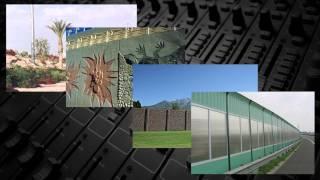
Noise Barrier
Anyone who’s ever ridden on an interstate highway will have seen noise barriers lining portions of the road. The Noise Control Act of 1972 mandates them.
The noise from cars comes primarily from interaction of the tires on the pavement, whereas truck noise comes primarily from the engine, and as traffic moves faster, there’s also aerodynamic noise. Research shows that the noise from highways that are below grade is the most attenuated, so earthwork berms or concrete, masonry, or metal walls are erected to contain the noise.
Sound propagates in waves through the air, but also a big component of the sound travels along the ground. Because of this, some theatrical productions use what’s called a “stage mouse”, which is a microphone cradled on the floor with the capsule directed at the floor. A PZM (pressure zone microphone) also works by picking up the sound moving along a flat surface.
Farmers have noticed that the ambient sound is much quieter after a field has been plowed, since the ruts from the plow make the surface irregular, breaking-up the ground wave.
This fact was used to help design a sound barrier for the Amsterdam Airport, where the ground was smooth and flat, and the noise from the air traffic was particularly bothersome to its neighbors. The airport reshaped the ground surrounding the runways and created, what appears to be from the air, a giant diffuser. These large mounds interrupt the ground wave and greatly reduce the noise pollution.
The noise from cars comes primarily from interaction of the tires on the pavement, whereas truck noise comes primarily from the engine, and as traffic moves faster, there’s also aerodynamic noise. Research shows that the noise from highways that are below grade is the most attenuated, so earthwork berms or concrete, masonry, or metal walls are erected to contain the noise.
Sound propagates in waves through the air, but also a big component of the sound travels along the ground. Because of this, some theatrical productions use what’s called a “stage mouse”, which is a microphone cradled on the floor with the capsule directed at the floor. A PZM (pressure zone microphone) also works by picking up the sound moving along a flat surface.
Farmers have noticed that the ambient sound is much quieter after a field has been plowed, since the ruts from the plow make the surface irregular, breaking-up the ground wave.
This fact was used to help design a sound barrier for the Amsterdam Airport, where the ground was smooth and flat, and the noise from the air traffic was particularly bothersome to its neighbors. The airport reshaped the ground surrounding the runways and created, what appears to be from the air, a giant diffuser. These large mounds interrupt the ground wave and greatly reduce the noise pollution.
Тэги:
#noise_barrier #barrier #sound_barrier #Noise_Control_Act #ground_wave #stage_mouse #PZM #pressure_zone_microphone #plowed #Amsterdam_Airport #diffuser #Mr_Audio #Mister_Audio #Sound_Images #highwayКомментарии:
Noise Barrier
MrAudioSoundImages
LOCALIZA SEMINOVOS
TV DO CARRO
Latah Thailand lucu
Kiki Amelia
KARAOKE Sương Trắng Miền Quê Ngoại - Nhạc sống | Guitar Bolero Mái Lá - Tone Nam
Ducmanh : guitar - Bolero
How to make lake pigment from madder root dye?
The Green Hippopotamus
Soulwave - Vadlovak
SoulwaveOfficial


























